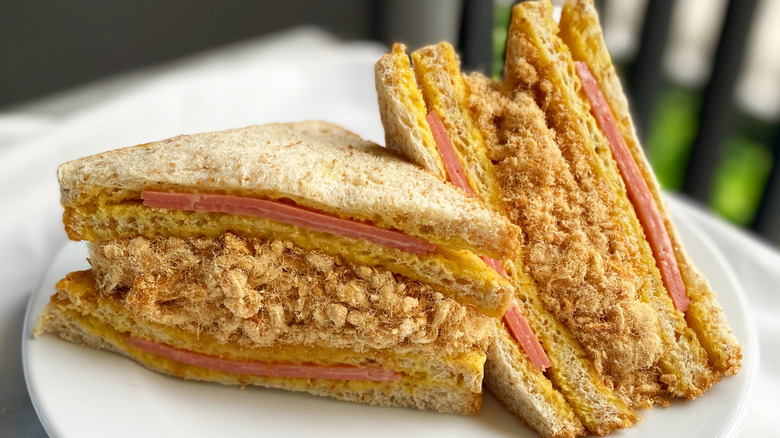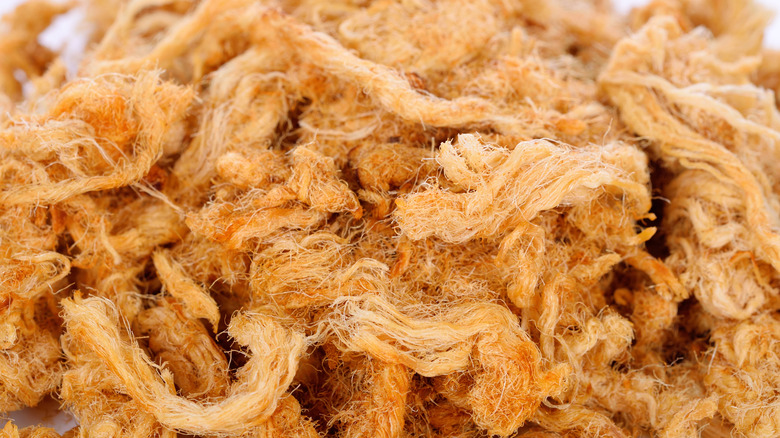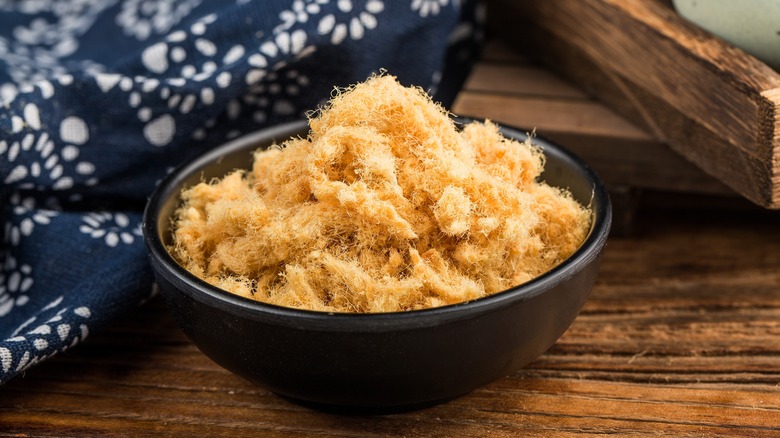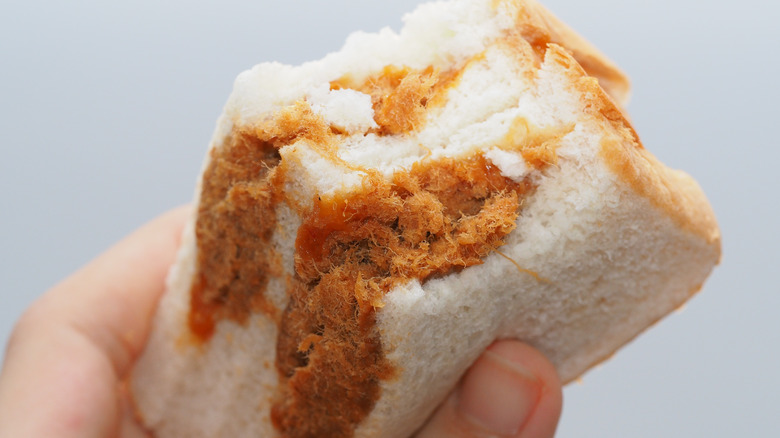Moo Yong Sandwiches Are An Amalgam Of Textures You Need To Try
Versatile and savory, shredded pork floss is one ingredient that can infuse many dishes with a much-needed splash of meaty flavor. It's got an unusual wispy, fuzzy appearance that might make texture-sensitive folks turn away and squint in suspicion, but for the adventurous eater, it's quite the salty-sweet delicacy. If you've never tried it before, imagine the melt-in-your-mouth feeling of cotton candy — except it tastes like jerky, with a hint of soy sauce.
Even more intriguing than pork floss is a popular Thai breakfast creation, the moo yong sandwich, which layers the shredded meat thickly between slices of white bread. Not only that, but this sandwich also contains spicy oils, sweet sauces, more meat, and a gooey egg yolk custard to glue it all together. It's got us wondering if this could be one of the greatest sandwiches of all time, based not only on how much texture there is but also on how many different flavors the sandwich marries together.
The history of pork floss
If this savory sprinkle was Genghis Khan's favorite treat, it definitely deserves a chance to prove itself. In Asian cuisine, pork floss is frequently added to anything from noodle-based meals to onigiri made with sticky rice, and is almost always eaten alongside the renowned Chinese comfort food, congee. Also called rousong, pork floss is a common pantry go-to for cooks who need to toss a quick dash of umami-rich flavors into their dish, and is generally purchased rather than made by hand, since it can be quite the tedious process.
Over 800 years ago, Genghis Khan and his Mongol soldiers traversed Asia carrying dried strips of meat very similar to pork floss. In his travel musings, the famed Italian merchant Marco Polo even recorded running into Mongol troops carrying the meat. Mongolians collected meat from reindeer, cows, horses, and even camels to hang in the open air of their yurts, which typically took one full month to completely dry. The slabs of dried meat were broken up into wispy pieces, called borts, and stored in linen bags for easy transport on long journeys. Pork floss eventually started getting mass-produced in the 19th century and became widely used in many Asian dishes. In today's world, not only does pork floss upgrade baked potatoes and other starchy favorites, it can be used in salads, stews, or simply eaten as a snack, just like you would munch on a bag of salty pork rinds.
Gather the ingredients to make your moo yong sandwich
To recreate this fully stacked sandwich-within-a-sandwich, white bread is the typical choice, although you can use other types of bread if you don't mind losing out on some fluffy exterior sweetness. Besides a hefty helping of fibrous pork floss, the extra meat tucked inside will be none other than your average deli bologna. If you've ever indulged in some of the best Thai food out there, you'll know that chili oil is a must. Depending on your tolerance level for spiciness, you don't need to use much if you prefer to keep things from getting too hot. If you've got a palate for more sweetness, mayonnaise is another ingredient typically slathered onto the moo yong sandwich to balance out the spice factor.
This dish will also usually have a creamy, orange-tinted sauce oozing from its center, which is traditionally made with egg yolk, condensed milk, lime juice, mayo, oil, and salt. If you really want that authentic, vibrant hue, you can choose to mix in a little bit of orange food coloring. For a more savory moo yong sandwich, throw in some chopped scallions or even diced mushrooms to align it with more common breakfast fare.
How to make moo yong sandwiches
It goes without saying that a sandwich like this has many unique variations, so there isn't exactly one correct way to stack your fillings. As long as mounds of cloud-like pork floss sit as the centerpiece of your Thai-style feast, you're on the right track. Simply take a slice of white bread, such as the colorfully-labeled Wonder Bread, and spread some mayo on before adding a slice of bologna. On goes another piece of bread with however much chili sauce your taste buds are comfortable with, topped with pork floss. Yet another bread slice will get coated in chili oil and slapped on top of the shredded floss, followed by another layer of mayo, another piece of bologna meat, and covered with the last layer of bread, finally.
For home chefs going the extra mile who want to create the dish's signature orange sauce, grab a mixing bowl and whisk the ingredients together to properly blend them. Then boil the sauce for five to seven minutes to get it nice and gooey. You can add however much onto any layer of the moo yong sandwich you'd like.
Where to find moo yong sandwich ingredients
Besides the easy-to-find white bread, bologna, and mayo that will be layering your moo yong sandwich, you can find the star of this culinary feat, pork floss, at your local H Mart or Asian market. There are two common flavors — the first type, called dried pork sung, tends to be darker in color and tastes more seasoned than the other, pork fu, which is lighter in both flavor and color. If you can't find pork floss at Asian specialty stores, you can purchase it on Amazon. Two popular brands are Formosa and Kimbo, or if you're feeling especially patient, you can opt to make it yourself.
Making pork floss isn't overly complicated, it just takes time. To make it, chop a few pork tenderloins into chunks and place them in a pot of salted water. Add ginger, green onion, and soy sauce, and simmer for 40 minutes. Once it's cooled and tender, the easiest way to shred it is by placing the pork in a plastic bag, rolling with a rolling pin to separate, and vigorously fluffing it all with clean hands. Alternatively, you could toss it in a pressure cooker for 20 minutes. For a drier texture, place the pork floss into a lightly oiled pan and fry for three to four minutes.
If you're lucky, you can also find the sandwich at select Asian eateries.




